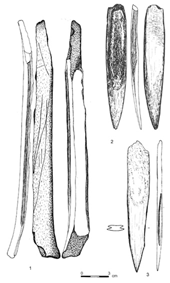 |
Fig. 1. 1- Stanovoye 4, III layer; 2 Ozerki 5, IV layer; 3 Okayomovo 5, III layer.
|
Offprint from: Alice M. Choykie, Laszlo Bartociewicz (edz). Crafting bone: Skeletal Technologies through Time and Space. BAR International Series 937. 2001, pp. 149-156.
Mickle G. Zhilin
Technology of the manufacture of Mesolithic bone and antler daggers on Upper Volga.
Abstract: Excavations of stratified peat sites, carried out by the author on Upper Volga during last years, gave large number of various bone artifacts. Among these, daggers and huntersknives are plenty. Preforms and half-finished daggers were also found togeter with lithic tools, used for bonework. Traceological studies let the author identify various traces, left by lithic tools on the surface of bone artifacts. Long tubular bones of large mammals, mainly elk, were used for making of the majority of daggers. Groove and splinter" technique was employed for longitudal cutting of tubular bones into halves, or into splinters of the desired size and shape. Direct percussion with hammerstones was also applied, supplemented usually by more fine retouch.. Secondary treatment included cutting, planing, scraping, with the help of lithic, usually, flint burins, knives, scrapers. Sawing was used very rarely. Larger portions of waste material were cut off with axe or adze. Abrasive slabs were used for grinding, while fine polishing was achieved with the help of leather, sometimes with fine dust-like abrasive agents. The sequence of operations in production of daggers was the following: 1) chopping off (breaking off) epiphezes of tubular bone; 2) obtaining a splinter of bone or cutting it into halves; 3) removal of unnecessary mass of bone with the help of hammerstone, axe (adze) or burin and scraper - creation of a pre-form; 4) cutting of slots for inserts (for composite daggers); 5) planing of the surface with a knife, carving of details, drilling of holes and engraving of ornamentation. 6) final polishing, binding of handles of some of them. Besides tubular bones, lateral metapodia, ulnae of elk, red deer and brown bear, elk and deer antler were also used. Heavy carving was mostly used for making daggers of these materials. The study showed high degree of development of bonework, standartisation of designs and technological operations, especially during late Preboreal and Boreal time, when composite daggers were most widespread.
Key words: Mesolithic bone daggers, Upper Volga, technology, manufacture.
Introduction
Intensive field surveys, carried out by the author in 1988-1999 resulted in discovering of more than 50 peat sites in the Upper Volga basin, about 20 of them have Mesolithic cultural layers with preservation of organic materials, 13 of them were excavated. Abundance of lithic tools made possible comparison of peat sites with "sandy" ones and accurate cultural attribution of the former. As a result, we have now complexes of lithic and organic remains, characterising the whole spectrum of prehistoric life, placed in relieable cultural-chronological framework, supplied with data on the development of the environment. Finished and half-finished daggers, blanks for their production and waste, accompanied by lithic tools, used for manufacturing of bone artifacts, give good opportunity to study technology of manufacturing of bone and antler daggers using various methods.
Beginning of the Mesolithic in Central Russia is traditionally connected with the transition from Pleistocene to Holocene, which is dated on Upper Volga to approximately 10000 B.P. The climate and vegetation changed several times during the Mesolithic (Spiridonova, Aleshinskaya, 1996; Zhilin, 1998). Beginning of the Preboreal (about 10000-9500 B.P.) is marked by gradual spread of birch-pine forests, which resulted in the leading role of the taiga type forest in the landscape about 9600 B.P. Since that time forest is the main element in the landscape, though its composition changed through time. About 7800 B.P. taiga gives place to mixed forests of the temperate zone, which dominated in the landscape up to the Atlantic optimum. Emergence of pottery about 7100 B.P. marks the end of the Mesolithic.
Faunal remains from habitation sites show, that throughout the whole Mesolithic various forest animals were hunted. Elk was most important since the earliest period up to the Neolithic. Beaver was the second important animal, hunted mainly for its meat, judging from numerous butchering marks, preserved at various beaver bones. Among others red deer and roe deer, brown bear, wild pig, badger, otter, wolf, fox, hare were occasionally hunted, but even put together, occupy quite modest place, compared with elk and beaver. Reindeer is represented by single bones and played no important role even in early Mesolithic. Fowling and fishing were also important since early Preboreal, their role gradually increased. Hunting and fishing were supplemented by food-gathering, both inland and water edible plants and mollusks were used.
Three main cultures are distinguished on Upper Volga in the first half of the Mesolithic (Koltsov, 1989; Zhilin, 1995). The Ienevo culture is linked with the Lyngby-Ahrensburgian tradition, only one site, Stanovoye 4 gave some bone artifacts, no daggers among them. The Resseta culture is poorly studied, it was spread in the first half of the Boreal, possibly slightly earlier. Bone tools are scarce, no daggers are known there. The Butovo culture emerged on Upper volga in early Preboreal and is connected mainly with population of the Swiderian culture. Bone and antler artifacts are numerous at peat sites, including about 20 types of arrowheads, various barbed points, spearheads, daggers, fishing hooks and a wide range of tools, used in everyday life: knives, perforators, needles, woodcutting tools, scrapers and burins-scrapers, punches and pressure-flakers, accompanied by numerous ornaments, made mainly from animal teeth. This culture developed during the whole Mesolithic and was the basis for the formation of the local early Neolithic. All daggers, analised in the present paper, belong to this culture.
Straight daggers, made of tubular bones.
Primary treatment of bone and antler depended upon the type of raw material used and, on the other hand, upon the desired size and shape of the finished dagger. Thegroove and splinter technique, well-known in the European Mesolithic was widely used for producing blanks for various types of daggers. Longitudal grooves were cut with a burin, which usually had a narrow working edge from one to the other end of a tubular bone at the depth of 2/3 to 5/6 of the thickness of the bone wall. The distance between such grooves regulated the width of the blank and the finished dagger. After the grooves were finished, the bone was split into long splinters (fig. 1, 1). It is worht noting, that epiphyses of the bone were usually removed before making longitudal groves for obtaining blanks for daggers. In other cases the bone was longitudally cut with epiphyses preserved, and preserved part of it was used as a tip of the handle (fig. 3, 2). In the simplest way they were simply broken off, but usually either cut off with an axe or adze, or a transverse cut was made with a chisel or a saw, and after it epiphyses were broken off.
 |
Fig. 1. 1- Stanovoye 4, III layer; 2 Ozerki 5, IV layer; 3 Okayomovo 5, III layer.
|
If the removal of such blank was successful, the simplest straight flat daggers were made by cutting off useless parts of the blank with a burin, planing the surface first with a scraper, and then with a knife, and a dagger was ready (fig. 1, 2). Slotted variants of the same, or similar types (fig. 1, 3; 2, 2,3) were first supplied with one or two slots for microliths, and only then carefully planed and often polished. Traces of a flint burin are visible only inside the groove. After it slots were filled with glue (fig. 2, 3 represents longitudally broken dagger, where glue is visible in slots), which was made of coniferous pitch, usually with admixture of bee wax and often with charcoal dust. The glue in slots was heated and microblades, usually without any retouch were placed in slots. Our experiments showed, that it was sufficient to hold a dagger for several minutes just above burning charcoal to make the glue melt in slot. It did not run out of the slot, so it was possible to fix microblades in the slot at the opposite side. When several inserts remained, they are stuck into the slot in such a way, that dorsal sides are faced in one direction, and ventral in th opposite. Microblades are usually of the same size and often, judjing by peculiarities of flint, were removed from the same core. When the dagged cooled, such glue held microblades very tightly, so at many occasions they crushed, but did not fall out. Very rarely in final Mesolithic microblades were sharpened with fine flat ventral retouch, but normally they bear only use-wear traces. Among other features, often, but not obligatory met, are perforations at the end of the handle (fig. 2, 2; 3, 1; 5), used probably, for attaching some thin belt or rope. They are always made from two faces, either by drilling with a borer, or just cutting or scraping with a burin (compare fig. 5 1 and 2). Often a natural hole is slightly widened with a burin (fig. 3, 2). The next feature is some transversal shallow cuts, indicating the border between the blade and the handle (fig. 2, 1; 6, 1).
 |
Fig. 2. 1 - Stanovoye 4, III layer; 2,3 Ivanovskoye 3, IV layer.
|
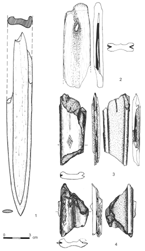 |
Fig. 3. 1 Podozerskoye peat bog, stray find; 2-4 - Stanovoye 4, III layer.
|
Besides flat, massive blanks were also made with the use of groove and splinter technique, which were shaped into daggers by ways, described above (fig. 2, 1; 6, 1). Of special interest are specific blanks, made by the same technique from such portions of tubular bones, which had longitudal ribs and depressions, so the cross section of these daggers was more complicated. Such daggers are met in late Preboreal and early Boreal time (fig. 3). Large number of such fragments suggest, that it was done initially to supply the thin blade of a dagger with these ribs, making it more resistant to breakage. Many such daggers are ornamented by geometric designs, composed of very thin lines, engraved by a very sharp burin, most probably, a broken flint blade. After being ornamented the most part of these daggers was carefully polished, most probably by a dry hide, judging from typical hide polish. Numerous striations indicate, that the hide was not clean, possibly initially coated with some very thin abrasive agent when it was raw or wet, just like modern abrasive hide (paper or textile). Glossy polishing was made by clean hide at the final stage of manufacturing process.
The other technique was also used for making preforms for massive long straight or slightly concave daggers. Large tubular elk bones were split into halves by hard hammerstone, after which the interior, concave part of a tubular bone was trimmed with crude flaking and fine retouch to make it flat, while the outer surface remained convex (fig. 4). After this was over, a burin, scraper, knife and borer were used for secondary treatment of such preform, shaping it into finished massive dagger (compare fig. 4, 1 and fig. 5, 1). Preforms, made of tubular bones, other than metapodia, were less specialised. Daggers of various shapes and sizes were made of them (fig. 5, 2; fig. 6, 1 for example). Before being shaped into finished daggers, after flaking massive preforms were put for some considerable time into the water to make bone softer, what was important for planing, cutting and scraping. All intact massive blanks (fig. 4) were discovered in gyttia layers near the shoreline of the settlement. Most probably, after soaking they were heated to make them even more soft. This is well known from ethnography. On the contrary, the bone should be dried before flaking, otherwise the flaking will not be successful.
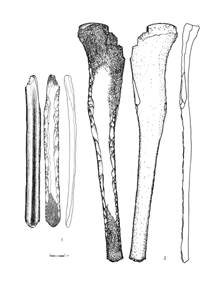 |
Fig 4. 1-2 Ivanovskoye 7, III layer.
|
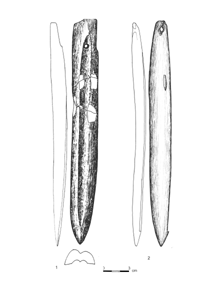 |
Fig. 5. 1 - Okayomovo 5, III layer; 2 - Stanovoye 4, III layer.
|
Other types
Various flat bones were also used for making daggers, sometimes, of rather sophisticated form (fig. 6, 2). Traces of primary treatment are not seen, possibly, in this case, there was no need to make any preform, and the dagger was shaped from the very beginning with the help of burin and scraper, and later also with a knife and borer. The slot was made in an ordinary manner, inserts unretouched microblades were fixed with 3-component glue, described above. Clear traces of binding, possibly with stripes of leather or birch bark are seen at handles of some daggers (fig. 6). Usually this binding traces run over the hole in the handle, so the belt or rope started from under this binding. The same is also observed at perforated handles of other types of daggers.
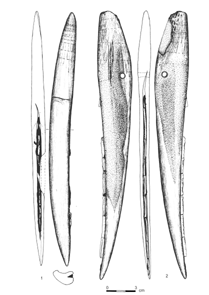 |
Fig. 6. 1,2 - Stanovoye 4, III layer.
|
Curved daggers were made of antler, the shape of the raw material either dictated the form of the finished dagger, or demanded too much work to make it straight. Antlers of most cervidae are curved. Main tasks for the Mesolithic craftsman in this case were: 1) sharpening of one end, usually the end of the antler beam, 2) making slots for inserts and mounting of the latter with the help of glue, 3) shaping of the handle. The first operation was carried out with a knife, at least no traces of burin or scraper were observed. Usually the surface of the antler beam was also carefully planed and no traces of natural antler surface are seen. Slots were made with a burin in the same way, as described above. The treatment of a handle was more individual: either it was carefully planed with a hole, drilled at the end, and bound with birch bark (fig. 7, 1), or it was just roughly cut with an adze and slightly planed (fig. 7, 2), or it was very carefully narrowed with two holes, perforated in it (fig. 8, 1). Tha last variant suggests the use of some solid, probably wooden or bone handle with a hollow for the tang of the knife, like many such artifacts were made in later times. Antler daggers are rarely met and most of them are individual.
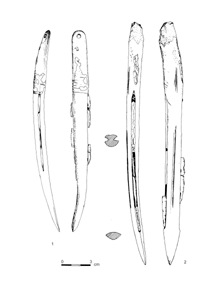 |
Fig. 7. 1,2 - Zamostje 2, after V.M. Lozovski, 1996.
|
Daggers with an oblique blade are more common, they were made either from various flat bones, or from ulnae of large mammals. The first variant was made with the help of direct percussion of a preform, after which the blade was carefully planed with a knife. Traces of initial flaking and retouch are sometimes clearly seen (fig. 8, 2). Making daggers of elk (fig. 9, 1) or brown bear (fig. 9, 2) ulnae included two main operations: 1) sharpening of the thin end, which served as a blade, and 2) shaping the thick end into a handle. An oblique cut near the end of the bone was made with a burin, creating a point of the dagger, the other lateral edge remained straight. Both edges and parts of surfaces near the point were sharpened by planing and sometimes polished. Protruding parts of the bone, which made obstacles for a good grasp by a hand, were chopped off, or broken away by direct percussion with a hammerstone, or cut off with a burin. The latter left deep cutmarks, later removed by planing, but usually some are still visible at a blade, or handle of such daggers (fig. 9).
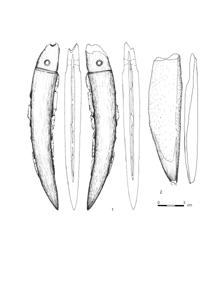 |
Fig. 8. 1 - Stanovoye 4, III layer; 2 - Ivanovskoye 7, IV layer.
|
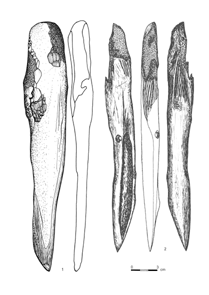 |
Fig. 9. 1 - Ivanovskoye 7, IV layer; 2 - Ozerki 5, IV layer.
|
The last group of daggers is composed of piercing artifacts with blunt edges, which were not used for cutting. These are called stylettes. Some were made of lateral metecarpal bones of elk and red deer (fig. 10, 1). This bone is already almost finished stylette, and it was only needed to sharpen its end by accurate planing. Epiphyses were preserved, and some such artifacts were ornamented and polished. Other type of similar, but longer and more massive daggers was made of splinters, cut from elk tubular bones, as described above. Blunt lateral sides are planed by a knife, the point is sharpened by accurate planing, and the handle is shaped by longitudal cuts with a burin. Traces of binding are visible at handles of some such artifacts.
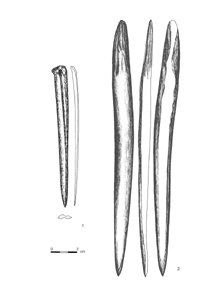 |
Fig. 10. 1 - Okayomovo 5, III layer; 2 - Stanovoye 4, III layer.
|
Results of the investigation described above, show, that technology of the manufacture of bone and antler daggers in Central Russia in the Mesolithic was well developed and rather sophisticated. All main methods of bonework were employed for making these artifacts. Good knowledge of raw material and preference of specific bones for each type of daggers is well seen. Standartisation of technological schemes and methods is observed in production of most widespread daggers. At the same time some rare types, especially, antler daggers show individual approach in each case.
Such important and powerful weapon, as dagger, emerges on Upper Volga in the early Mesolithic and survives until late Neolithic. The most complicated in manufacture were composite daggers with flint inserts, which could be called hunters knives, also very effective for butchering. They were most widely spread during the middle Mesolithic. Later their number decreases rapidly, which is connected with the general decrease of the role of composite weapons. More primitive daggers with only piercing functions demanded less time and efforts for their production. At the same time in early Neolithic a well developed trend for making large flint knives is observed. It led to mass production of large flint daggers and hunters knives, which replace bone daggers in the middle and late Neolithic.
References
Koltsov L.V. 1989, Mezolit Volgo-Okskogo mezhdurechya, in Mezolit SSSR. Arheologia SSSR, ed Rybakov B.A, Moscow, pp. 68-87.
Lozovski V.M. 1996, Zamostje 2, Editions du CEDARC, Treignes.
Spiridonova E.A., Aleshinskaya A.S. 1996, Osobennosti formirivaniya i struktury rastitelnogo pokrova Volgo-Okskogo mezhdurechja v epohu mezolita, in Tverskoi arheologicheski sbornik, ed. Chernyh I.N., N2, Tver, pp. 65-70.
Zhilin M.G. 1993, Kostyanoye vooruzheniye drevneyshego naseleniya Verhnego Povolzhya, Russkaya ravnina publications, Moscow.
Zhilin M.G. 1995, The Western Part of Russia in the Late Palaeolithic - Early Mesolithic, in The Earliest Settlement of Scandinavia, ed. Lars Larsson, Acta Archaeologica Lundensia. 80, Lund, pp. 273-284.
Zhilin M.G. 1998, Technology of the manufacture of Mesolithic bone arrowheads on Upper Volga, European Journal of Archaeology, 1:2, pp. 149-176.